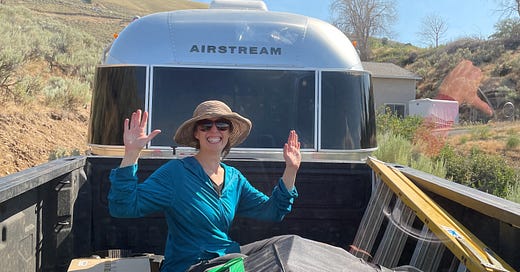
Installing an Espar Heater in a Sprinter Camper Van
Perfect Espar heater installation weather.
We almost skipped installing an Espar D2 heater in our Sprinter camper van. With 20/20 hindsight and many sub-freezing nights logged, it is officially one of our favorite things in the van, with the fridge (perhaps) beating it out by a sliver.
Except that I’m writing this post during a rare rainstorm in Joshua Tree and our heater is cranking away keeping my fingers warm while I look out at the desert, so the fridge is losing points fast! (For more background on our full build-out, check out the adventure mobile post.)
All in all, our Espar is fabulous. We've run it about 50 150 250hours so far without any issues whatsoever. One thing I've heard from blog readers is that the high altitude kit can be handy or else the unit will soot up and need to be serviced. That said, we've spent days and days above 6,000' elevation and our Espar hasn't required a cleaning yet. When it does, this is a handy resource for trouble shooting the unit, cleaning it out and hopefully fixing the problem.
Since I spent a fair number of hours dealing with the install and couldn’t find much except scattered and often incomplete forum posts on the InterWebs, I wrote up the following install process for how I put in our Espar D2 heater. (Installation of the Espar D4 heater is exactly the same, so far as I can tell.)
I recommend doing it in a heated shop, or in the summer while drinking a cold beverage, rather than the November weather in Idaho that I experienced. Sleet, snow and rain are sub-optimal install partners...
Where to Buy It
For a decent deal at $995, check out Bunk Heaters. I also considered Snugger, a less expensive version of the Espar. Either way, you'll save a bundle versus buying from a dealership. If you're doing the install yourself, definitely buy online.
Deciding to do the install myself was a simple process after getting quotes of $1,000-$2,000 from the brain surgeons apparently needed to do the work. RIPOFF ALERT. The install may sound intimidating, but you can do it! And if you screw it up, hey, vans are cheap - buy another one. Your loving partner will understand, right? If not, you can sleep in your freezing-cold van...
Frankly, you can do this install. Dozens of blog readers have used my writeup to successful install a (working) Espar heater in their van. Grab fortune by the britches and get after it! (Yep, I just used britches in a sentence.)
But first, remember you're doing this install so you can hang out in places like the below!
Alpine Trail, Oakridge, OR
Why I Bought an Espar D2 Heater versus D4
I went with an Espar heater because 1) it can run on diesel, which means I could tap into the main fuel tank for our van and avoid installing propane or other fuel sources and 2) everyone else did it and Sprinter Jedi Mind Control works on me.
I bought an Espar D2 heater, which is smaller than the D4, after reading that you want the heaters to run on “boost” (high power) in order to avoid fouling the combustion mechanism inside the unit.
Our van is insulated with anywhere from R-11 to R-14 on the walls and ceiling (none in the floor) and the heater has kept us warm down to about 22 degrees in the cold and damp redwood forests of the Northern California coast, the cold spring in Durango, the mountains of Colorado, plus dry and freezing desert nights in SoCal. We haven't done much winter camping in it, but I'm confident it would perform well.
Fuel economy on these things is amazing. Even at full boost mode, it burns just one gallon of gas in 20 hours (!), and it doesn’t run that high most of the time. (It's apparently 50 hours per gallon at the lowest heat level.) For the heat output, it is quite an efficient unit and seems well worth the price.
In case you are considering not getting a heater: If your van is insulated and lacks an internal heat source, it will turn into an ice box. Some people may think body heat will warm up your van. From personal experience and testing this on numerous shorter trips prior to this one, I can say this... They. Are. Wrong. Put in a heater or your less cold-resistant partner is going to stay home while you road trip alone crying quietly into your cold ramen at night.
Want the real details? Read on.
By the way, dig these kinds of posts? Sign up for the free 2x/month Traipsing About newsletter for more van tales, plus creative challenges like drawing and piano.
Install Tips
-Set aside a weekend for the job. I did it in a day, but that doesn't include the initial trip to an auto parts store to get supplies.
-Recruit people to help. An unsuspecting friend, or incredibly helpful father-in-law (thanks again Steve!), will make life 12x easier. Damage done to that relationship excluded...
-Getting the Sprinter up on blocks or a hoist to get more space under the van will make your life 1.2 million times easier. It can be done without it - I survived - but take my word for it. Your elbows and back will thank you. Especially if it’s sleeting and the ice water pools under the van on the tarp...just sayin’.
Sub-optimal working conditions... At least my father-in-law is under the van while I'm cramped in the bike garage. #vanlifefun
-Something to watch out for: while the wires for the thermostat and heater power are 12’ long, the pump wire is only 7’ long...which can (did) create some issues depending where you place your heater. I have no idea why they don’t make the wires the same length.
-Strong recommendation: install a combination smoke/CO detector in your van. They're small, cheap and can save your life.
-If you have an ‘08 or newer Sprinter (the NCV3 or newer), you MAY not need the ~2' fuel pickup pipe that comes with the unit. For most Sprinters from 2008-2014, the helpful folks at Mercedes put a fuel tap on the front left side of the fuel tank that makes it quite easy to install the tubing without dropping the fuel tank and drilling a hole in the top. YES. According to a blog reader (see comments below), from 2015 onward, the fuel tap is optional and not included on the Sprinter Worker package, so you may need the tap.
-Buy the $36 muffler from BunkHeaters.com. Our heater sounded like a rocket headed to Mars before I installed the muffler two months into our trip. Your neighbors in camp will appreciate it, trust me. It’s a super easy install.
-Consider installing the high altitude kit if you are going to be camping at elevation (such as the Rockies). This avoids fouling the Espar (the elevation messes up the fuel/air mixture and makes it run too rich). I didn’t do it, but it is worth considering. (Update Jan 2017: For what it's worth, we've spent many nights above 6,000' with the heater running and have not had issues in three years. Other readers who spend weeks at high altitude have had issues, so I'd err on the side of caution.)
-I read about some guy cutting off the “extra” wiring harness on the unit after he installed the thermostat and fuel pump wiring. That’s the diagnostic port! Leave it there.
-The fuel pump wiring will not go through the same routing hole as the intake/combustion beneath the unit. You have to run it through the floor of the van somewhere else.
Connections You'll Need to Hook Up
Intake air for combustion from outside the vehicle - black flexible hose provided with the unit.
Exhaust air from combustion to the outside of the vehicle - silver, heat-resistant ribbed metal hose provided with the unit.
Fuel line from the main diesel tank under the van, routed through the fuel pump that comes with the heater (more below on that specific item).
Thermostat control wiring - this stays internal to the van. Just follow the color-coded instructions on the wiring, it’s straight-forward.
Power wiring - I ran this directly into a fuse in our 12v panel.
Intake/Heating air ducts - I installed our heater so that the heating air snout for the heating unit pokes into the main living space, with the intake end of the unit in the bike garage. This has worked well and air circulates through the van without running a large amount of duct work, which I wanted to avoid. The air temp of the hot air isn't too high, but I'd recommend at least 6-12" of open space so you don't roast your floor or other surface in the van. Installing under the front passenger seat seems like a popular option, but that's where our subwoofer goes (priorities, right?) so I can't speak to that personally.
Here is how I went about installing the heater in our 2013 Sprinter (same as 2008-2013). Please note this is the same process as 2007 and earlier models except that you’ll need to drop the fuel tank and install the fuel pickup that the Espar D2 or D4 heaters come with. Check out www.sprinter-source.com for information on that.
Install process
Figure out where your heater is going to go and measure all wires, duct work, and fuel lines to make sure you have enough material. Then add 10-20% slop so you avoid stretching wires tight or running out of fuel line halfway. I ended up having to relocate the fuel pump and the shorter wire presented a headache.
To attach the stock Mercedes Sprinter fuel tank to the Espar fuel line, read all the directions in the installation manual and then perhaps follow what I did:
Buy a short (<12”) piece of 5/16” black flexible fuel line, two clamps to fit it and a metal male-male connector that is ¼”.
The 5/16” fuel line slips over the fuel tap from the Mercedes tank. Then you insert the ¼” connector into that, which then inserts into the ~3/16” (5mm) fuel line that comes with the Espar D2. Make sure to clamp all connections.
Clamped down, the fuel lines are snug around the connector and you can run the 5/16” fuel line directly to the fuel pump for the Espar heater. The instructions clearly give you max distances and orientation for everything.
1/4" male-to-male adapter prior to putting on hose clamps.
The fun (scary!) part: cut a 4x6” rectangle in your wood floor. Note: you can cut all the way through the metal, but I don’t recommend it. Instead, just cut through the floor (a hole saw worked great for me) to get the clearance from the exhaust pipe and then drill smaller holes that allow the intake/combustion pipes to exit. There is a template provided with the heater that makes this easy. File down sharp edges on the holes and install heat-resistant muffler putty on the wood. I also folded up some aluminum foil and lined the inside of the wood just to reflect some heat back. Probably overkill, but it was easy.
Paint to seal the cut, file and a hook blade to cut through the flooring.
Two 4" hole saw cuts and holes drilled for the fuel line (center) and intake/exhaust.
The seal that comes with the heater will mash down on top of the floor and seal out grime and dirt. I don't think it is necessary to cut a huge gaping hole in the metal when it just takes a couple holes.
Holes cut and sealed with heat resistant putty behind the reflective foil.
You’ve got your holes drilled. Before routing the intake/exhaust pipes, clamp them to the unit. Otherwise you’ll be doing it on your back and it will be impossible or make you hate life and any word starting with "Espa..." A little foresight here saved me some serious pain.
Heater with piping clamped and ready to install.
Fuel line and intake/exhaust ducting run? Route any internal ducting, or at least think about where it is going to go. Perhaps reference step #1 again.
Run your thermostat, power and fuel control wiring per the diagrams. (See how easy that was? Just one sentence that will take you a couple hours. Enjoy! )I think connecting to the house (not engine) battery is the best way to go since you don't want to drain the battery that starts the engine.
First install for the heater...BACKWARD. *Slaps forehead* The finned silver end puts out the heat. Easy to flip around at least. Note to self: read instruction manual.
FIRE UP THE BEAST. At first, all you’ll hear is a clicking of the fuel pump as it fills up the fuel line for the Espar. Do not despair if the unit “malfunctions” and says there isn’t enough fuel to start combustion. Reset it and do it again. It took three times through for ours to start. In the meantime, I cursed, kicked some stuff, and practiced other Zen methods of stress control. The manual doesn’t tell you to just let it run. I hopefully just saved you some frustration and early gray hairs.
That’s it! The details are in the the instruction manual and will cover most of it, yet I think a few little pointers like this could have saved me a considerable amount of time.
Drop me a line if you have any questions about your install. First question is free and then I demand Synergy kombucha drinks delivered cold to my van door after mountain bike rides! Cheers to staying warm on the road.








